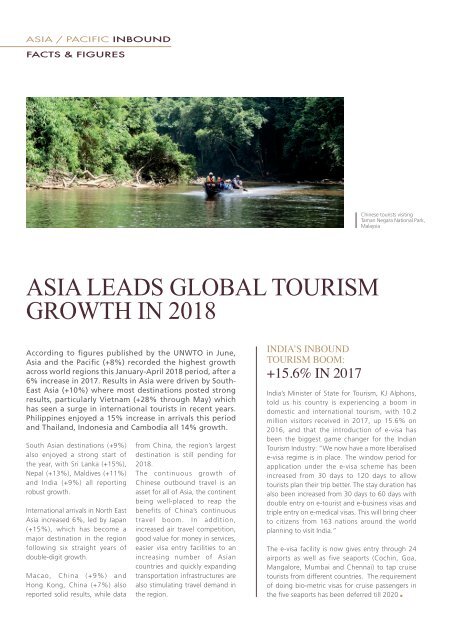Hotel & Tourism SMARTreport #39
You also want an ePaper? Increase the reach of your titles
YUMPU automatically turns print PDFs into web optimized ePapers that Google loves.
ASIA / PACIFIC INBOUND<br />
FACTS & FIGURES<br />
Chinese tourists visiting<br />
Taman Negara National Park,<br />
Malaysia<br />
ASIA LEADS GLOBAL TOURISM<br />
GROWTH IN 2018<br />
According to figures published by the UNWTO in June,<br />
Asia and the Pacific (+8%) recorded the highest growth<br />
across world regions this January-April 2018 period, after a<br />
6% increase in 2017. Results in Asia were driven by South-<br />
East Asia (+10%) where most destinations posted strong<br />
results, particularly Vietnam (+28% through May) which<br />
has seen a surge in international tourists in recent years.<br />
Philippines enjoyed a 15% increase in arrivals this period<br />
and Thailand, Indonesia and Cambodia all 14% growth.<br />
South Asian destinations (+9%)<br />
also enjoyed a strong start of<br />
the year, with Sri Lanka (+15%),<br />
Nepal (+13%), Maldives (+11%)<br />
and India (+9%) all reporting<br />
robust growth.<br />
International arrivals in North East<br />
Asia increased 6%, led by Japan<br />
(+15%), which has become a<br />
major destination in the region<br />
following six straight years of<br />
double-digit growth.<br />
Macao, China (+9%) and<br />
Hong Kong, China (+7%) also<br />
reported solid results, while data<br />
from China, the region’s largest<br />
destination is still pending for<br />
2018.<br />
The continuous growth of<br />
Chinese outbound travel is an<br />
asset for all of Asia, the continent<br />
being well-placed to reap the<br />
benefits of China’s continuous<br />
travel boom. In addition,<br />
increased air travel competition,<br />
good value for money in services,<br />
easier visa entry facilities to an<br />
increasing number of Asian<br />
countries and quickly expanding<br />
transportation infrastructures are<br />
also stimulating travel demand in<br />
the region.<br />
INDIA’S INBOUND<br />
TOURISM BOOM:<br />
+15.6% IN 2017<br />
India’s Minister of State for <strong>Tourism</strong>, KJ Alphons,<br />
told us his country is experiencing a boom in<br />
domestic and international tourism, with 10.2<br />
million visitors received in 2017, up 15.6% on<br />
2016, and that the introduction of e-visa has<br />
been the biggest game changer for the Indian<br />
<strong>Tourism</strong> Industry: “We now have a more liberalised<br />
e-visa regime is in place. The window period for<br />
application under the e-visa scheme has been<br />
increased from 30 days to 120 days to allow<br />
tourists plan their trip better. The stay duration has<br />
also been increased from 30 days to 60 days with<br />
double entry on e-tourist and e-business visas and<br />
triple entry on e-medical visas. This will bring cheer<br />
to citizens from 163 nations around the world<br />
planning to visit India.”<br />
The e-visa facility is now gives entry through 24<br />
airports as well as five seaports (Cochin, Goa,<br />
Mangalore, Mumbai and Chennai) to tap cruise<br />
tourists from different countries. The requirement<br />
of doing bio-metric visas for cruise passengers in<br />
the five seaports has been deferred till 2020

















